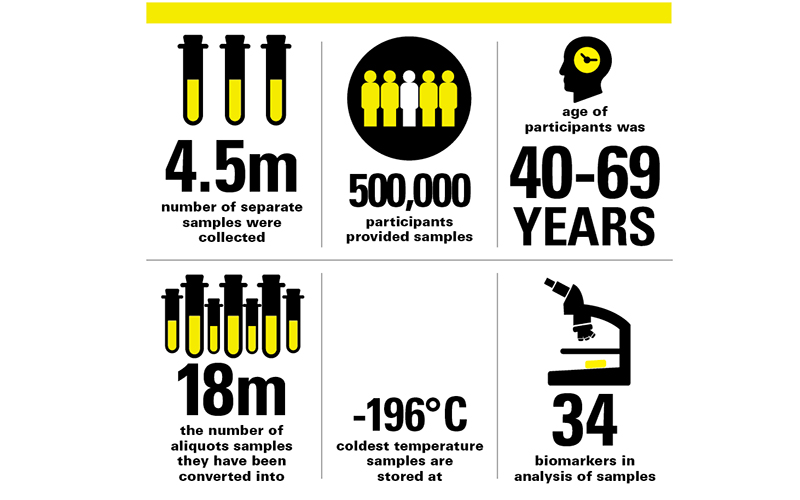Parmesher Singh explains the work that is being undertaken at UK Biobank and the impact that it is hoped to have.

Tucked away on an industrial estate in Stockport, lies a major national and international resource. The adage “looks can be deceptive” certainly applies when most people first lay eyes on a large warehouse guarded by two towering liquid nitrogen silos. This is in fact the UK Biobank co-ordinating centre and currently it houses the UK Biobank Biomarker Enhancement Project laboratories. This facility was initially the co-ordinating centre during baseline recruitment and sample collection, but now houses: multi-purpose laboratories (six in total, three of which are the Biomarker laboratories), automated stores for participant sample storage, an imaging assessment centre and offices. The site (including laboratories) is ISO 9001:2015 and ISO 27001:2013 accredited and the laboratories used for the Biomarker Enhancement Project are also ISO 17025:2015 accredited.
These three ISO accredited laboratories were set up to measure a wide range of biochemical markers from biological samples collected at baseline from approximately 500,000 participants aged between 40 to 69 years old. Participants were recruited during 2006 to 2010, from 22 assessment centres across England, Scotland and Wales. UK Biobank is a large prospective cohort study with the aim to improve the health of future generations by understanding why some individuals are more susceptible to certain diseases than others.
Analysing biomarkers
The Biomarker Enhancement Project forms one of several projects designed to enhance the UK Biobank resource by adding supplementary data. Other enhancement projects include genotyping, imaging and activity measurements. The biomarkers were selected by the UK Biobank’s Enhancements Working Group, following consultation with scientific experts to identify biomarkers that are likely to be of most scientific relevance for studying a broad spectrum of diseases. Selected biomarkers were chosen because they are established risk factors for disease (e.g. lipid markers for vascular disease), diagnostic measures (e.g. HbA1c for diabetes) or characterise phenotypes not otherwise well assessed (e.g. biomarkers for renal and liver function). Analysis of biomarkers was performed for the whole cohort (500,000 participants) and on three sample types; urine, packed red blood cells and serum.
Data for the four urine biomarkers (which include urine creatinine and microalbumin – chosen for their association with diabetes), are already available to the scientific research community via access to the UK Biobank Data Showcase, available is on its website. These were measured on a single clinical chemistry analyser. Hba1c analysis is complete and data is currently being reviewed prior to release to researchers in 2018. HbA1c was measured on packed red blood cells, rather than whole blood samples using 5 HPLC systems. Serum analysis comprised 29 different biomarkers, the majority of which are commonly measured in routine clinical chemistry laboratories (AST, ALT, calcium, phosphate, creatinine, urea etc.), along with more specialised markers, such as IGF-1, vitamin D, cystatin-C, rheumatoid factor, and lipoprotein (a). Serum analysis utilised 10 immunoassay analysers (two different platforms) and four clinical chemistry analysers (two different platforms). Analysis of serum is now complete with data review ongoing. It is anticipated that serum data release will be in 2018.
In total, the UK Biobank biomarker laboratories have analysed 34 different biomarkers on approximately 500,000 samples – over 17 million results. At the peak of analysis, up to 2,000 samples were analysed per day for the urine phase of the project and up to 1,900 samples per day for serum. Analysis of the three sample types has taken almost four years to complete. As the samples are a precious resource, laboratory quality is paramount thus an extensive and rigorous internal quality control (IQC) regime utilising Westgard rules and sigma-metric scores have been implemented during the project, typically consisting of analysing multiple levels of QC material every 200 samples. Over 720,000 separate IQC measurements have been performed and validated. In addition, the biomarker project registered with at least four different EQA providers to maintain and comply with ISO 17025 standards. Furthermore, data is reviewed regularly with experts at the Clinical Trial Service Unit and Epidemiological Studies Unit based in Oxford, with whom UK Biobank has close links.

Teamwork
Like all laboratories, the overall objectives cannot be reached without a dedicated and conscientious workforce.
Approximately 50 members of staff have been directly employed by the Biomarker project, supported by a wider number of staff from UK Biobank including – quality, the core laboratory team, human resources and information technology teams. The Biomarker project has typically consisted of three teams, two teams working seven-day shift patterns and one team working a five-day week to facilitate communication and handover across multiple shifts. Other than myself, there are two other senior HCPC registered Biomedical Scientists (Team Leaders) and we have over 45 years of combined experience in clinical chemistry. We report to a Project Manager/Laboratory Manager who is responsible for the overall management of the project. As team leads on this project, our duties and responsibilities include; analyser/method verification and validation, managing stock control and liaising with manufacturers, implementation and development of overall technical quality aspects, training laboratory staff, assisting and ensuring quality management systems are adhered to, technical validation of results and troubleshooting, amongst many others. Each team consists of a Team Leader, Biomarker Specialists, Scientists, Technicians and Assistants, each playing a vital role in the completion of the project. Only a small number of the team are HCPC registered Biomedical Scientists, with the majority consisting of individuals with scientific qualifications, but limited laboratory experience. One of the many great achievements of the Biomarker project has been training and mentoring staff, to enable them to competently and independently run, maintain and troubleshoot common problems on the 20 analysers, as well as identifying and rectifying QC failures.
Another great achievement has been successfully obtaining ISO 17025:2015 accreditation for all the biomarker assays for each of the three sample types.
This was challenging, but with a lot of teamwork and many document-controlled procedures and forms later, accreditation was achieved ensuring the data available to researchers at the end of the project is of the highest standard.
Parmesher Singh is a Team Leader in the Biochemistry Lab at UK Biobank, along with Stewart Moffat and Mark Gordon.
For more information visit www.ukbiobank.co.uk




